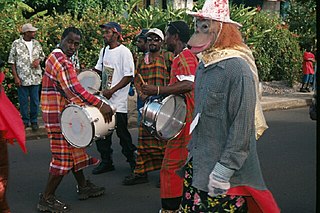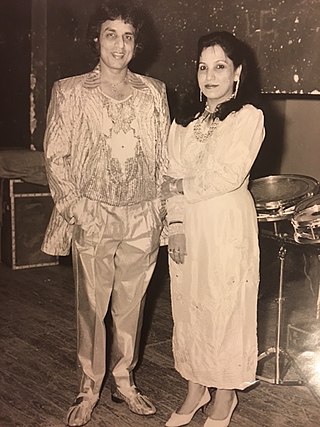Related Research Articles
Soca music is a genre of music defined by Ras Shorty I, its inventor, as the "Soul of Calypso", which has influences of African and East Indian rhythms. It was originally spelled "sokah" by its inventor but through an error in a local newspaper when reporting on the new music it was erroneously spelled "soca"; Lord Shorty confirmed the error but chose to leave it that way to avoid confusion. It is a genre of music that originated in Trinidad and Tobago in the early 1970s and developed into a range of styles during the 1980s and after. Soca was initially developed by Lord Shorty in an effort to revive traditional calypso, the popularity of which had been flagging amongst younger generations in Trinidad due to the rise in popularity of reggae from Jamaica and soul and funk from the United States. Soca is an offshoot of calypso/kaiso, with influences from East Indian rhythms and hooks.
Calypso is a style of Caribbean music that originated in Trinidad and Tobago during the early to mid-19th century and spread to the rest of the Caribbean Antilles by the mid-20th century. Its rhythms can be traced back to West African Kaiso and the arrival of French planters and their slaves from the French Antilles in the 18th century.
The music of Trinidad and Tobago is best known for its calypso music, soca music, chutney music, and steelpan. Calypso's internationally noted performances in the 1950s from native artists such as Lord Melody, Lord Kitchener and Mighty Sparrow. The art form was most popularised at that time by Harry Belafonte. Along with folk songs and African- and Indian-based classical forms, cross-cultural interactions have produced other indigenous forms of music including soca, rapso, parang, chutney, and other derivative and fusion styles. There are also local communities which practice and experiment with international classical and pop music, often fusing them with local steelpan instruments.

The music of Dominica includes a variety of genres including all the popular genres of the world. Popular music is widespread, with a number of native Dominican performers gaining national fame in imported genres such as calypso, reggae, soca, kompa, zouk and rock and roll. Dominica's own popular music industry has created a form called bouyon, which combines elements from several styles and has achieved a wide fanbase in Dominica. Groups include WCK, Native musicians in various forms, such as reggae, kadans (Ophelia Marie, and calypso, have also become stars at home and abroad.

The dholak is a two-headed hand drum, a folk percussion instrument. The dholak is most commonly recognised in countries such as India, Pakistan, Bangladesh, Nepal and Sri Lanka, but can also be found amongst the Indo-Diaspora in countries such as Guyana, Suriname, Fiji, Trinidad and Tobago, South Africa and Mauritius. The dholak can be anywhere about 16" to 24" in length. It is widely used in qawwali, kirtan, bhajan, bhangra, chutney, baithak gana, Bollywood film songs, lokgeet and various classical styles such as Hindustani, Carnatic and Trinidadian local classical / Guyanese taan. The drum has two different sized drumheads. There is a smaller drumhead that can be from 5.5 to 8 inches in diameter and is made for sharp notes while the bigger drumhead, which can be from 7.5 to 10 inches in diametre, is made for low pitch. The two drumheads allow a combination of bass and treble with rhythmic high and low pitches. The body or shell of the Dholak can made of sheesham or mango wood. The larger drum head has a compound of tar, clay and sand, called "masala" which is applied to lower the pitch and produce the sound. The smaller drumhead is played with the person's dominant hand, while the larger is played by the person's weaker hand. A dholak can either be fitted with a nuts and bolts or a rope and steel rings for tuning. Commonly in the Indian subcontinent, there are only one set of rings for tuning the treble side of the dholak, while in the Caribbean, hook screws are placed into the sides of the dholak to allow tuning of both the treble and the bass. Dholak can be played in three ways — on the player’s lap, while standing, or pressed down with one knee while sitting on the floor.
The music of the Lesser Antilles encompasses the music of this chain of small islands making up the eastern and southern portion of the West Indies. Lesser Antillean music is part of the broader category of Caribbean music; much of the folk and popular music is also a part of the Afro-American musical complex, being a mixture of African, European and indigenous American elements. The Lesser Antilles' musical cultures are largely based on the music of African slaves brought by European traders and colonizers. The African musical elements are a hybrid of instruments and styles from numerous West African tribes, while the European slaveholders added their own musics into the mix, as did immigrants from India. In many ways, the Lesser Antilles can be musically divided based on which nation colonized them.
Chutney music is a fusion genre of Indian folk music, specifically Bhojpuri folk music, with Caribbean calypso and soca music, and later with Bollywood music. This genre of music that developed in Trinidad and Tobago is popular in Trinidad and Tobago, Guyana, Suriname, Jamaica, other parts of the Caribbean, Fiji, Mauritius, and South Africa. Chutney music emerged mid-20th century and reached a peak of popularity during the 1980s. Several sub-genres have developed.

The music of Suriname is known for kaseko music, and for having an Indo-Caribbean tradition.

The music of Antigua and Barbuda is largely African in character, and has only felt a limited influence from European styles due to the population of Antigua and Barbuda descending mostly from West Africans who were made slaves by Europeans.
The music of Guyana encompasses a range of musical styles and genres that draw from various influences including: Indian, Latino-Hispanic, European, African, Chinese, and Amerindian music. Popular Guyanese performers include: Terry Gajraj, Eddy Grant, Dave Martins & the Tradewinds, Aubrey Cummings, Colleˊ Kharis and Nicky Porter. Eddie Hooper The Guyana Music Festival has proven to be influential on the Guyana music scene.
Ras Shorty I, born Garfield Blackman and also known as Lord Shorty, was a Trinidadian calypsonian and soca musician, known as the Father of Soca and The Love Man.

Rakesh Yankaran, nicknamed The Raja is an Indo-Trinidadian musician. He is the son of the late Indian classical musician, Isaac Yankarran and brother of the late Indian classical and chutney musicians Anand, Suresh, and Sharm Yankaran. His grandfather came from Andhra Pradesh, India to Trinidad and Tobago during the indentured labour times. He is a self-taught musician. As a child, young Rakesh loved to listen to his father sing. As a teen he started to play music himself. Today he is a professional chutney artist. He can play the Indian instruments tabla, dholak, harmonium, dhantal, and the tassa drum.
The culture of Trinidad and Tobago reflects the influence of Indian-South Asian, African, Indigenous, European, Chinese, North American, Latino, and Arab cultures. The histories of Trinidad and Tobago are different. There are differences in the cultural influences which have shaped each island. Trinidad and Tobago is an English-speaking country with strong links to the United Kingdom.

Laxmichand "Babla" Virji Shah and Kumari Kanchan Dinkarrao Mali-Shah were an Indian husband-wife musical group best known for work in the chutney music and Desi Folk music genres. They performed together for forty years until Kanchan died in 2004. Babla Shah is the younger brother of famous music director duo Kalyanji Anandji.
Drupatee Ramgoonai is a Trinidadian and Tobagonian chutney and chutney soca musician. She was responsible for coining the term "chutney soca" in 1987 with her first album, entitled Chutney Soca, which included both English and Hindustani versions of the songs. She had her biggest hit the following year when her "(Roll Up the Tassa) Mr. Bissessar" was a Road March contender. She was instrumental in tassa and chutney soca finding its place in Carnival and her efforts later led to competitions such as Chutney Soca Monarch.
Sundar Popo HBM, born Sundarlal Popo Bahora was a Trinidadian and Tobagonian musician. He is credited as being the father of Chutney music, beginning with his 1969 hit Nana and Nani.

Caribbean Hindustani is an Indo-Aryan language spoken by Indo-Caribbean people and the Indo-Caribbean diaspora. It is a koiné language mainly based on the Bhojpuri and Awadhi dialects. These Hindustani dialects were the most spoken dialects by the Indians who came as immigrants to the Caribbean from Colonial India as indentured laborers. It is closely related to Fiji Hindi and the Bhojpuri-Hindustani spoken in Mauritius and South Africa.
Samdeo "Sam" Boodram was a Trinidadian Chutney, Bhajan, Indian classical and folk singer, Kabir Panthi mahant, and cocoa farmer. He recorded over 6,000 songs over the span of his career.
References
- ↑ Peter Manuel, "Chutney and Indo-Trinidadian cultural identity," Popular Music 17:1 (1998): 37 JSTOR, Online (4 December 2007).
- ↑ Lorriane Leu, "'Raise Yuh Head, Jump up and Get on Bad!': New Developments in Soca Music in Trinidad", Latin American Music Review 21:1 (2000): 51 JSTOR, Online (4 December 2007).
- ↑ Manuel (1998): 37 and 42.
- 1 2 Manuel (1998): 38.
- ↑ Helen Myers, "Trinidad and Tobago", The New Grove Dictionary of Music and Musicians Vol. 25, ed. Stanley Sadie (Taunton, Mass.: Macmillan, 2001), p. 742.
- ↑ "Chutney Soca Succession". caribbean-beat.com.